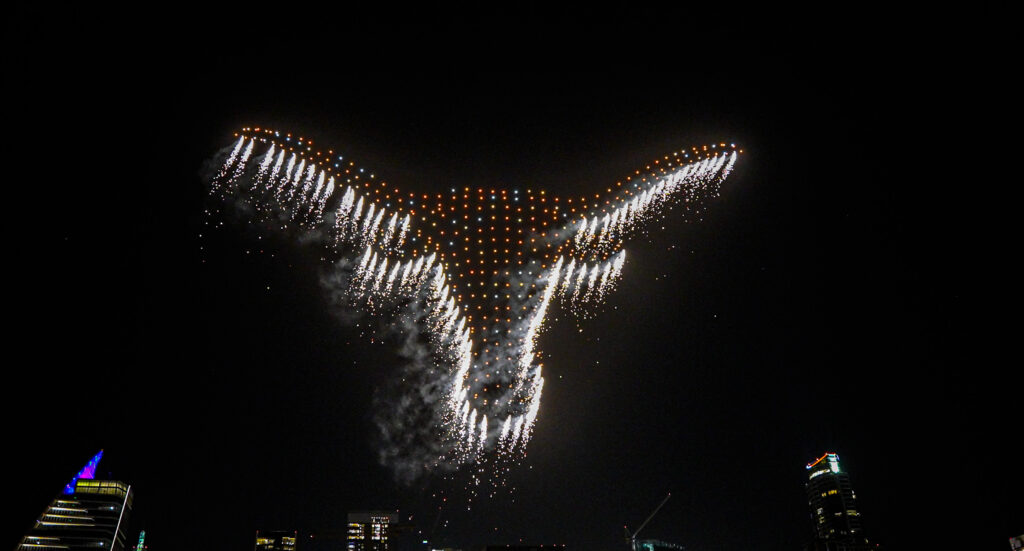
The Artistry Behind Drone Choreography
In the world of entertainment, few things are as mesmerizing as a perfectly choreographed drone show. Each drone moves with precision and purpose, creating intricate patterns, symbols, and even messages in the sky. This art form combines cutting-edge technology with artistic creativity, transforming the night sky into a canvas of light and movement. At FlyLight Drone Shows, we believe that the beauty of a drone show lies not only in the technology but in the artistic thought that guides every drone’s movement. Let’s dive into the artistry behind drone choreography and explore how these aerial ballets captivate and inspire audiences worldwide.
What Goes into Planning a Drone Show
Every great drone show begins with careful planning. To create a visual masterpiece, our team of designers works on drafting concepts, developing storyboards, and planning each sequence in minute detail. Drone choreography is about more than just positioning drones; it’s about storytelling. Each show has a theme, whether it’s a brand message or a celebration, and the movement of each drone is meticulously planned to convey that theme.
Planning also involves understanding the physical space and environmental factors. In a city like Dallas, where drone shows are becoming popular, it’s crucial to work with experts who consider factors like wind, light pollution, and crowd visibility. This comprehensive planning ensures that each show is a seamless blend of art and technology, providing an unforgettable experience.
The Role of Animation in Drone Choreography
Animation is at the heart of any drone choreography. Just like in traditional animation, where individual frames are used to create movement, each position of the drones is a “frame” in the larger picture. Software designers and animators work together to create sequences where drones move from point to point, creating flowing shapes and designs. These animations require advanced software capable of precise calculations, allowing designers to program movements that look fluid and lifelike. The result is a display that seems to dance across the sky, captivating the audience with every turn, loop, and burst of light. This blend of animation and choreography is what makes drone shows so artistically compelling.
How Drone Shows Are Synced with Music
Syncing drone choreography with music adds an entirely new dimension to the performance. Music sets the pace, guiding each drone’s movement and enhancing the emotional impact of the visuals. Each beat, rhythm, and pause in the music is matched by the drones, creating a harmonious performance that engages multiple senses. To achieve this synchronization, choreographers use software that maps the drone movements to the music’s tempo and beats. This process is highly complex, as it requires precision down to the millisecond, but when done correctly, it creates a captivating, immersive experience. The fusion of light, movement, and sound transforms the show into an art form that audiences won’t forget.
The Role of Lighting in Drone Choreography
Lighting plays a crucial role in drone choreography, adding depth, color, and emotion to each performance. LED-equipped drones can display a vast spectrum of colors, and by carefully selecting these colors, choreographers can evoke different emotions and moods. Colors are often chosen based on the theme of the show, such as warm hues for celebrations or cool shades for more reflective pieces. Each light sequence is pre-programmed, allowing the drones to change colors in perfect sync with their movements. This control over lighting lets choreographers paint the sky in vivid detail, creating images and scenes that resonate with audiences. The artistry of lighting turns a simple drone display into a powerful visual experience.
Creating Custom Shapes and Symbols with Drones
One of the most impressive aspects of drone choreography is the ability to create shapes and symbols in the sky. By programming drones to take specific positions, choreographers can form everything from hearts to logos, and even complex designs like animated figures or animals. This customization is what makes drone shows such a powerful tool for brand promotion and artistic expression. Custom shapes allow companies and event organizers to convey messages in a visual format that captivates and engages. For example, a drone show in Dallas could display the city’s skyline, a team logo, or a holiday symbol, making each performance meaningful and relevant to its audience. This personalization is what sets drone shows apart from other visual displays.
Challenges of Drone Choreography
Creating a synchronized drone show is not without its challenges. Wind, weather, and unexpected environmental conditions can impact the stability and visibility of drones. Choreographers must plan for these variables, creating backup plans and adjusting sequences to ensure a smooth show regardless of conditions. Additionally, choreographers must ensure that each drone moves in sync with others to avoid collisions. The complex calculations involved require highly skilled professionals who understand both the artistic and technical aspects of drone choreography. This attention to detail is what allows a breathtakingly smooth performance, despite the inherent challenges.